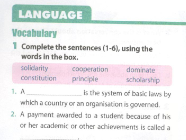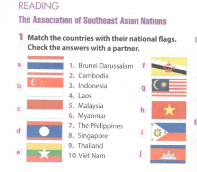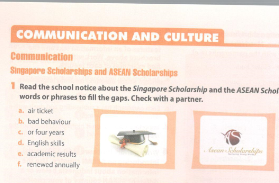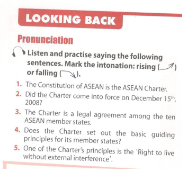
Skills trang 50 Unit 4 SGK Tiếng Anh 11 mới
1. Look at the pictures. Can you recognise the people? What disabilities do you think they had?
- Bài học cùng chủ đề:
- Communication and culture trang 54 Unit 4 SGK Tiếng Anh 11 mới
- Looking Back trang 55 Unit 4 SGK Tiếng Anh 11 mới
- Project - trang 57 Unit 4 SGK Tiếng Anh 11 mới
- Ngữ pháp tiếng anh hay nhất
READING
1. Look at these symbols. They are used to indicate acccss for people with disabilities. Write who each symbol is for. (Hãy nhìn những biểu tượng này. Chúng được dùng để chỉ những người khuyết tật. Hãy viết ra xem mỗi biểu tượng đó dành cho người nào.)
1. people with mobility impairments / disabilities
2. people with visual impairments / disabilities
3. people with hearing impairments / disabilities
4. people with speech impairments / disabilities
2. Match each of the words with its meaning. Use a dictionary , if necessary. (Hãy ghép mỗi từ theo đúng nghĩa của nó. Sử dụng từ điển nếu cần.)
1. b 2. d 3. e 4. a 5. c
3. Read a school magazine report on some interviews with class monitors. Choose the appropriate heading for each paragraph. (Hãy đọc bài tường thuật trên tạp chí học đường về một số cuộc phỏng vấn lớp trưởng các lớp. Hãy chọn tiêu đề phù hợp nhất cho mỗi đoạn.)
* Đáp án
1. b 2. c 3. a
4. Complete these sentences with no more than three words. (Hoàn thành mỗi câu với không quá ba từ.)
*Đáp án
1. students with disabilities
2. record popular books
3. participating fully in
4. "record-breaking"
5. this Christmas unforgettable
5. Discuss with a partner how can help children with disabilities in your community. (Thảo luận với bạn bên cạnh về cách giúp trẻ em khuyết tật trong cộng đồng bạn ở.)
* Học sinh làm theo yêu cầu.
* Bài dịch
Hãy giúp đỡ cộng đồng của bạn
(Theo Nguyễn Mai)
Các bạn học sinh trường Nguyễn Văn Trỗi đang chuẩn bị quà Giáng sinh cho học sinh khuyết tật ở thành phổ Hồ Chí Minh. Chúng tôi đã hỏi ba lớp trưởng đầy nhiệt huyết và cách lên kế hoạch làm cho lễ Giáng sinh của các bạn khuyết tật không thể quên được. Dưới đây là câu trả lời của họ.
1. Bạn Huỳnh Mai Liên, lớp trưởng lớp 11A đã nói:"Chúng tôi cho rằng học sinh khuyết tật cần nhận được sự ủng hộ làm những việc họ yêu thích." Sau khi đến thăm một trường đặc biệt, bạn ấy đã kết bạn với những học sinh khiếm thị. Bạn ấy đã nhận ra rằng họ rất thích đọc sách. Vì vậy bạn ấy đã quyết định thu âm những cuốn sách được yêu thích dành cho những bạn học sinh này. Liên nói một cách sôi nổi: "Tôi hy vọng các bạn ấy sẽ thích nghe những cuốn sách biết nói dành cho ngày lễ Giáng sinh".
2. "Món quà dành tặng tất cả mọi người" là câu khẩu hiệu của chiến dịch tặng quà của lớp 11B đứng đầu là Trần Nam. "Chúng tôi đã đồng ý mời các bạn khuyết tật tham gia vào các hoạt động của ông già Noel dành cho trẻ em trong vùng." Thậm chí có vài bạn trong số đó gặp trở ngại trong việc đi lại, họ vẫn có thể ăn mặc giống Ông Già Noel và giữa trao quà cho các em nhỏ. Nam nói: "Việc tặng quà giúp mọi người vui và bổ ích. Người khuyết tật vẫn có thể tham gia đầy đủ vào đời sống cộng đồng."
3. "Chúng tôi muốn làm một cái bánh Khúc Cây Giáng Sinh thật đặc biệt. Mọi người đều đã bắt đầu đóng góp tiền vì thế chúng tôi có thể mua tất cả các nguyên liệu." Hoa, lớp trưởng lớp 11C đã nói vậy. Hoa còn nói thêm: "Mỗi người đều có trở ngại riêng, không ai hoàn hảo cả. Với sự giúp đỡ của các bạn ở trường đặc biệt, chúng tôi nghĩ mình có thể làm được điều gì đó tuyệt vời." Lớp bạn ấy muốn làm một cái bánh Khúc Cây Giáng Sinh phá kỷ lục: đó là cái bánh dài nhất từ trước đến nay mà do phần lớn các em học sinh làm. "Vào ngày lễ Giáng sinh, chúng tôi sẽ mời các em nhỏ trong vùng đến dự tiệc mừng Giáng sinh và làm bánh Khúc Cây Giáng sinh dài nhất."
SPEAKING
1. Read the following phrases. Write R if it expresses a reason why people volunteer and A if it expresses a voluntary- activity. (Hãy đọc những cụm từ dưới đây và viết R nếu cụm từ đó diễn tả lý do người ta làm tình nguyện và viết A nếu cụm từ đó diễn tả hoạt động tình nguyện.)
|
1. improve yourself |
R |
|
2. coach children who want to do a sport |
A |
|
3. meeting interesting people |
R |
|
4. change people's lives |
R |
|
5. organise extracurricular activities |
A |
2. The principal of a special school is interviewing a potential volunteer. Complete the interview, using the words in the box. Then practise it with a partner. (Thầy/Cô Hiệu trưởng của một trường học đặc biệt đang phỏng vấn một tình nguyện viên có tiềm năng. Hãy hoàn thành cuộc phỏng vấn, sử dụng các từ cho trong khung, sau đó hội thoại với bạn bên cạnh.)
* Đáp án
1. volunteer position
2. special school
3. change people's lives
4. in the past
5. improve coordination
6. clearly and effectively
3. Read the information about two special schools in Viet Nam. Choose one of them. Work in pairs and make a similar interview as in 2. Ask why your partner wants to volunteer, what skills he / she can offer and how he / she can help. (Đọc thông tin về hai ngôi trường đặc biệt ở Việt Nam. Chọn một trong hai trường. Làm việc theo cặp và xây dựng một đoạn hội thoại tương tự như ở bài tập 2. Hỏi bạn bên cạnh tại sao bạn ấy muốn làm việc tình nguyện, bạn ấy có những kỹ năng gì và có thể giúp được gì.)
* Học sinh làm việc theo yêu cầu.
Vocational training: đào tạo nghề
LISTENING
1. Look at the pictures. Can you recognise the people? What disabilities do you think they had? (Hãy nhìn những bức ảnh. Em có nhận ra những người trong ảnh không? Theo em họ đã bị khuyết tật gì?
* Đáp án
1. Albert Einstein, learning disability
2. Ludwig van Beethoven, hearing loss
3. Thomas Edison, learning disability
2. Listen to a radio programme about a famous youngster with a disability and fill the information. (Hãy cùng nghe một chương trình radio nói về một người trẻ tuổi nổi tiếng bị khuyết tật và điền thông tin về người đó vào bảng)
Click tại đây để nghe:
* Đáp án
Name: Nguyen Anh
Nationality: Vietnamese
Kind of disability: Glass-bonc disease
Interests: Singing and helping charitablc campaigns
Title honoured by UNICEF: Global outstanding child with a disability
3. Listen again and complete the sentences with no more than four words or numbers. (Nghe lại lần nữa và hoàn thành câu với không hơn 4 từ hoặc số.)
Click tại đây để nghe:
* Lời bài nghe
Welcome to Gel Involved, our weekly programme about inspirational young people. Today, I'll tell you the amazing story of an outstanding young person with a disability.
Nguyen Anh was born with "glass-bone disease, a genetic disorder causing fragile bones, and had fractured bones over 30 times. She is unable to run around like her friends, and nas to use a wheelchair. Despite her disability, she always has a smile on her face. She believes that she is luckier than other people with disabilities because she has many >upportive friends and teachers.
Nguyen Anh has been interested in singing since an early age. Eager to join charitable campaigns, she has been using her talent to perform at Voice of Viet Nam since she was eight. She has taken part in broadcasting radio messages to rural villagers. She has been honoured by UNICEF as an outstanding child with disabilities. Now. as a Friend of UNICEF Viet Nam. she continues to inspire others, and use her talent and determination to help children with disabilities.
She became a success when she auditioned for the television show Viet Nam's Got Talent. She immediately received national and international recognition.
Her smile and kind voice will definitely continue to encourage people with disabilities to immediately their potential. Her inspiring words are what we would like you to think about. "You can do a lot of things if people believe in you and actually treat you equally."
* Đáp án
1. Get Involved
2. over 30 times
3. broadcasting radio programmes
4. friendly and supportive
5. treated equally
4. Work in groups. Ask and answer the question. (Làm việc theo nhóm, hỏi và trả lời câu hỏi.)
What can you do to support people with disabilities and help them to succeed in life?
* Học sinh làm theo yêu cầu.
WRITING
1. Read a student's article about a problem facing children with cognitive impairments, and the solutions she proposes. Put the phrases (a-c) in the appropriate spaces (1-3) (Đọc bài báo của một học sinh viết về sự khó khăn đang thách thức các bạn bị suy giảm về nhận thức và những giải pháp mà bạn ấy đưa ra. Hãy xếp các cụm từ từ a-c vào ô thích hợp từ 1-3.)
* Đáp án
1. c 2. b 3.a
2. Read the article in 1 again and complete the following outline. (Đọc lại bài báo ở bài tập I và hoàn thành dàn ý dưới đây.)
Introduction Children with cognitive impairments often face discrimination in life. Main body
Solution 1: People should learn more about children with cognitive impairments.
Solution 2: There should be more contacts between people with cognitive impairments and non-disabled people.
Conclusion: Better understanding and better cooperation between the two groups of people will change attitudes and reduce discrimination.
3. Choose one of the following problems and write an article of 160-180 words, using the outline in 2. You can use the suggestions below. (Chọn một trong những vấn đề dưới đây và viết một bài báo khoảng 160-180 từ, sử dụng dàn ý ở bài tập 2. Em có thể dụng những gợi ý bên dưới.)
* Bài viết gợi ý
Nowadays, while a lot of students live and study in good physical conditions, there rJ still many students with visual impairments. They are facing a lot of discrimination J life. They may feel that they are treated less fairly than normal students because of their disabilities. In regular schools, they cannot fully participate in school activities and aJ often left behind.
What can we do to help them overcome their problems? First, people should pay mudl attention to them and know what they need. They have different learning difficulties! however; that does not mean that they cannot learn. Therefore, schools should provioj them with specialised materials and tools such as Braille or large print books, talkirj computers or materials with large print. By giving them these things, we can help theJ learn better.
Second, there should be more close contacts between students with visual impairment and non-disabled ones. They should be put in a cordial atmosphere to work in groups! People should create an atmosphere of friendliness, respect and acceptance during afl activities at school. When working together with students with visual impairments, people will fully understand them and may recognise the talents hidden inside them. Tfci is the thing that all people in our society should do.
It is necessary for all people to give students with visual impairments more opportunitiei in life, and should intergrate them in our community because they are part of our socierJ Better understanding of students with visual impairments and more contacts between non-disabled people and disabled people will help students with visual impairmer overcome their difficulties and create a more possitive attitude towards them.
dayhoctot.com
- Unit 1: the generation gap
- Unit 2: relationships
- Unit 3: becoming independent
- Review 1 sgk tiếng anh 11 mới
- Unit 4: caring for those in need
- Unit 5: being part of asean
- Review 2 trang 70 sgk tiếng anh 11 mới
- Unit 6: global warming
- Unit 7: further education
- Unit 8: our world heritage sites
- Review 3 - sgk tiếng anh 11 mới
- Unit 9: cities of the future
- Unit 10: healthy lifestyle and longevity
- Review 4 trang 70 sgk tiếng anh 11 mới
- Tổng hợp từ vựng lớp 11 (vocabulary) - tất cả các unit sgk tiếng anh 11 thí điểm






